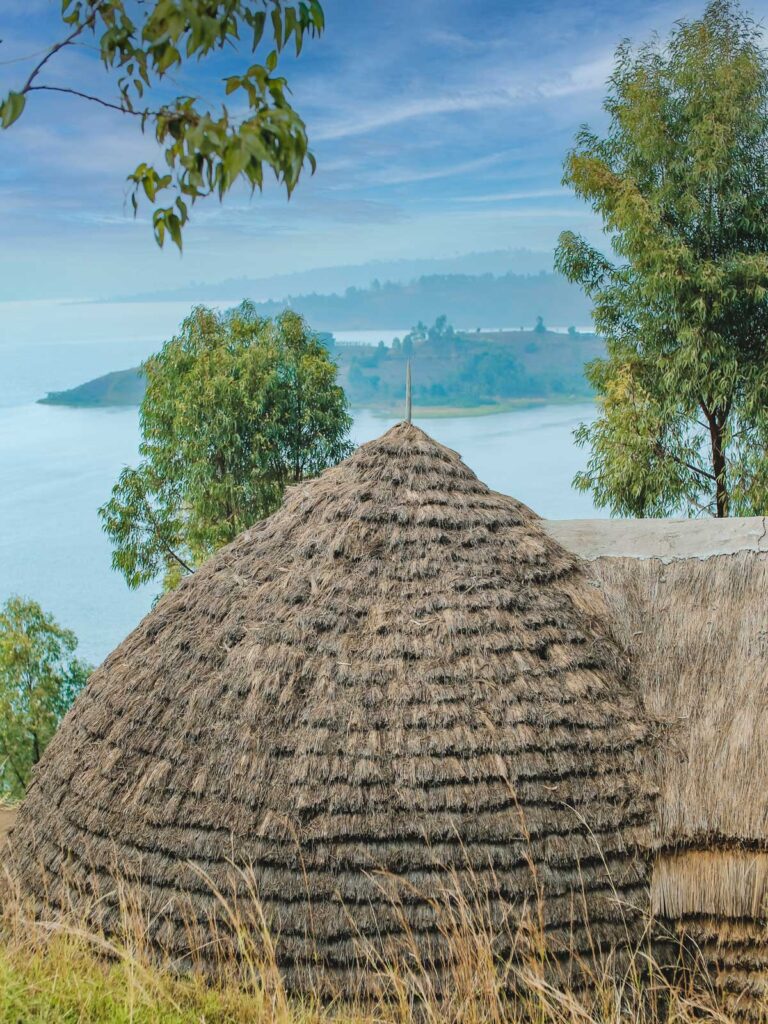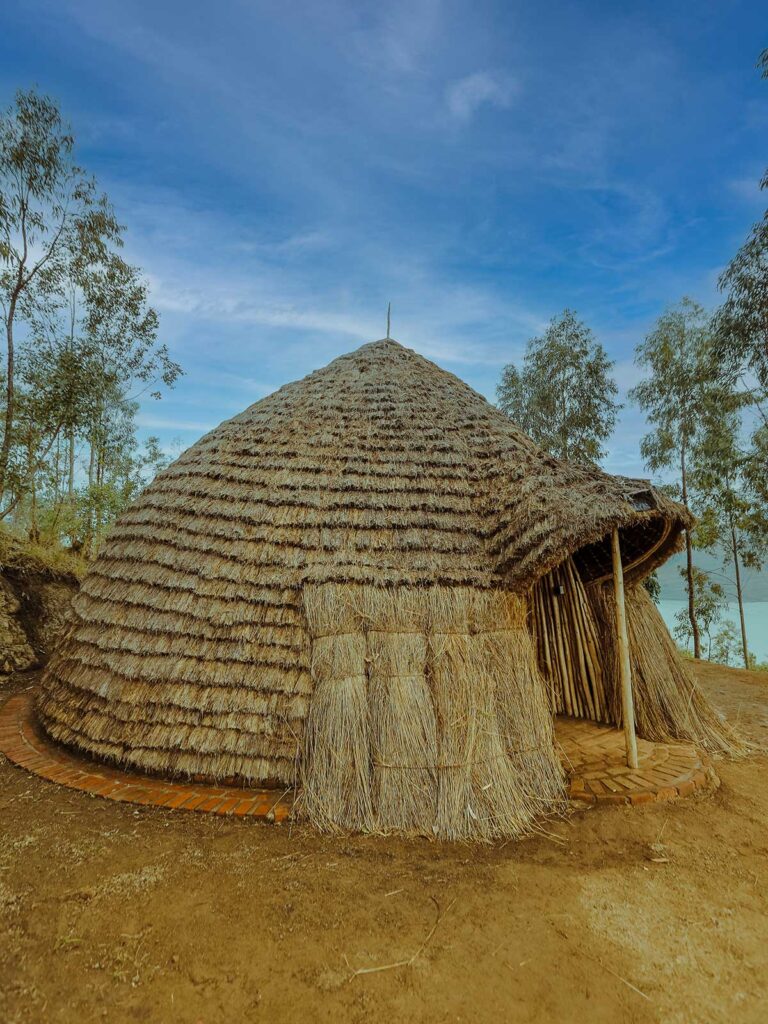The identity-building idea that gave rise to the projects in the villages of Santo Stefano di Sessanio and in the Sassi di Matera is to be repeated following a similar philosophy in another area of “social disadvantage”: on Nkombo Island, Lake Kivu, Rwanda.
An island on the borders of Rwanda and Congo, which is located in Rwandan territory but mostly populated by Congolese fishermen, farmers and herdsmen, engaged in a purely subsistence economy.
An island that welcomes western operators associated with religious organisations or NGOs just a few times a year.
The inhabitants of the island speak a dialect specific to the area, Mashi.
Oral tradition recalls that Rwandan girls who were pregnant but unmarried or married but rather liberal towards the concept of monogamy would be thrown into the lake near the Island of Fishermen and, once rescued by the latter, would be condemned to a status somewhere between domestic help and genuine slave.
The story goes that it is from the union of these Congolese fishermen and the Rwandan girls that the current resident population of the island was founded.
The Capanne Project came about because of exhibits found in the Ethnographic Museum of Rwanda (Butare), which contains traditional huts and the hut of the King of the Tutsi.
Both these types of huts are not unlike many others found in the mountains of equatorial rainforest. The slight poetic licence taken in this project, where original solutions were unworkable, take their cues from local building techniques, used in different contexts and for different purposes compared to the original ones but nevertheless showing no contemporary contamination.
Despite having to rely on simple, non-electric tools, the high quality of the raw materials and impressive artisan techniques result in a sleekness of style and proportions. The bathrooms, whilst not betraying the original atmosphere imparted by the project, offer WCs, bidets and hot-water showers.
The area where the huts are positioned is located on the northern tip of Nkombo Island on Lake Kivu, and is the part, which is furthest away from the mainland, has the lowest population density and is inhabited by a Muslim minority, who, despite their poverty, are known for their particularly elegant styles of female dress.
As on the rest of the island, life in our huts will also be one of self-subsistence through the farming of our land and the livestock rearing that characterise the local household economy.
Crops and animals are those traditionally found in equatorial villages with a few local peculiarities distinct to the island.
As far as crops are concerned, we can mention cassava, whose roots are used to make bugali and whose leaves sombe, sweet potatoes, beans, peas and corn, for making corn bugali and corn bouillie for breakfast.
Farmyard animals found are hens, sheep, goats, small black pigs, a donkey for transport and also sacred animals that cannot be killed, like long-horned cows. The latter originate from Tutsi farmers and produce milk, cheese and yoghurt. Lastly are the sheep, which, whilst benefitting from a less certain destiny, owe their survival to the fact that they accompany these cows.
A well-established tradition that no doubt goes beyond basic necessity is the production of “banana beer”, a local brew, found in many areas of the western equatorial rainforest.
A minor trading opportunity beyond self-subsistence will be the purchase of fish from local fishermen and the opportunity to eat the fish soups that are usually prepared at sunset with them. Furthermore, Rwanda’s best products will also be selected such as tea, coffee etc.
Additionally, there will be a chef who can somewhat widen the choice the local area offers in order to satisfy the many types of requirement our guests have.
In addition to the two huts, the dining area and the adjacent kitchen, a second kitchen, built in accordance with the strict regulations of this country, is located a little further away. The small village is rounded off with the custodian’s house and the house of the local family who run a small farm.
We have chosen the 21st March 2022 for our opening because we would like to train a local boy on the local flora and fauna, mainly plants and birds, and particularly on the anthropological aspect, covering some general concepts regarding Rwandan and Congolese culture. We would also like to carry out some interviews with the elderly of the island, starting with the boy’s relatives, as the population exhibits a certain religious syncretism and a number of pagan-like rites.
The huts contain traditional Rwandan beds with layered straw mats and mattresses. Bathrooms are equipped with shower, WC, bidet and hot water.
In-room amenities: wi-fi, safe, kettle and hairdryer. Daily housekeeping service included.
The communal areas comprise a dining area with a large table seating fifteen people, a barbecue area and a traditional open kitchen. The private beach has a landing stage for the Sextantio boat to dock, pajotte (open-sided thatched structure) and a lit bonfire in the evening.
Services included: pick-up from the airport of Kamembe with a transfer time of around 45 minutes by canoe to Nkombo Island. Kamembe is just a 40-minute flight away from the Rwandan capital of Kigali. There are currently five weekly flights scheduled between Kigali and Kamembe, operated by Rwanda Air.


sleeps four


sleeps two
Compared to a standard African resort, in the Capanne Project, the local anthropological aspect is the element on which the entire experience centres.
The attempt in this third project, in line with the previous two albeit in a more dramatic measure, is to prevent tourism from destroying the precarious natural balance of the area. In Italy, the problem lies in the difficulty of safeguarding the historical landscape of villages which have survived the last 70 years unscathed; in Africa the problem is purely a cultural one.
All these activities have the principal objective of maintaining the native social and cultural balance in order to preserve the dignity of the local populations and not to turn them into hordes of beggars or, in the best-case scenario, sellers of dubious local art and handicrafts, as happens in many African resorts. This will be the greatest challenge of a project which, although starting with the best intentions, has variables that are difficult to accurately predict.
Financed entirely by Sextantio members in the form of a NGO, which, since 2008, has supported the current project of providing health insurance to the neediest in Rwanda. The project targets the poorest part of the population, who, relying on self-subsistence, have real difficulties paying for insurance that is needed in order to treat extremely common diseases which are not costly to treat but have a high rate of mortality.
Rwanda is the only country among its neighbours with whom it has a shared history (Burundi and the Democratic Republic of Congo) in which the existence of these diseases, which are easily treated but can have a deadly prognosis, is not outwardly evident. This demonstrates the effectiveness of the health insurance project.
Malaria Prevention: 6500 cases per 100,000 every year.
Mosquito nets are still provided in each room as a precaution. You should still eliminate any risk by keeping your arms, legs and feet covered as much as possible after dusk (long, light-coloured sleeves and trousers are best) and cover exposed skin with a strong repellent. Mosquito repellent spray is provided in your room. However, it is always better to consult your doctor and be given personalised advice.
Yellow fever vaccination is not compulsory as the disease is not endemic on the island.
Sun Protection: A hat and sunglasses will protect you from the bright light. A high-factor sunblock applied liberally to exposed skin is essential. Avoid dehydration by drinking plenty of bottled water whilst in the sun.